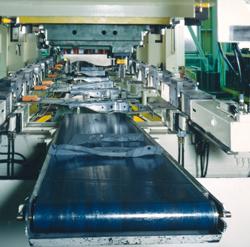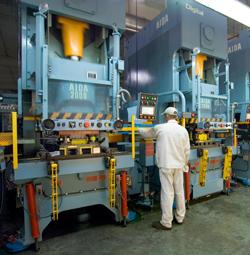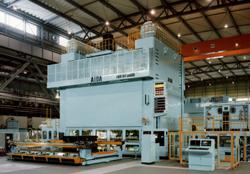- FMA
- The Fabricator
- FABTECH
- Canadian Metalworking
Categories
- Additive Manufacturing
- Aluminum Welding
- Arc Welding
- Assembly and Joining
- Automation and Robotics
- Bending and Forming
- Consumables
- Cutting and Weld Prep
- Electric Vehicles
- En Español
- Finishing
- Hydroforming
- Laser Cutting
- Laser Welding
- Machining
- Manufacturing Software
- Materials Handling
- Metals/Materials
- Oxyfuel Cutting
- Plasma Cutting
- Power Tools
- Punching and Other Holemaking
- Roll Forming
- Safety
- Sawing
- Shearing
- Shop Management
- Testing and Measuring
- Tube and Pipe Fabrication
- Tube and Pipe Production
- Waterjet Cutting
Industry Directory
Webcasts
Podcasts
FAB 40
Advertise
Subscribe
Account Login
Search
Metalforming lessons learned abroad
What U.S. stampers can learn from global counterparts
- By Dennis Boerger
- November 6, 2007
- Article
- Bending and Forming
The U.S. taught the world about mass production, but now it may be time for the teacher to take some notes on flexible approaches to metal forming.
After World War II, consumerism in the U.S. required that domestic manufacturers produce large quantities of the same product as quickly as possible. Engineers designed manufacturing systems that contained lines of equipment dedicated to the production of a single part or small family of parts to maximize output.
Meanwhile in Europe and Asia, consumer demand for automobiles, household appliances, and other manufactured goods developed at a slower pace. Equipment manufacturing companies in those areas designed production systems that were more flexible and worked to expedite part-to-part changeover.
Today this trend is hitting U.S. shores, and U.S. stampers are looking to Europe and Asia for ways to work more efficiently.
What's Pushing the Change?
Two factors are driving this change. First, a growing number of consumers want products tailored to their individual tastes. To meet the demand, manufacturers are designing and developing a much wider range of sizes and model types. Higher volume and longer production runs, in many cases, are giving way to orders for smaller batches and shorter part runs.
For example, this can be seen in the automotive industry where the overall unit sales volumes remain the same or continue to grow while the production numbers for any given model shrink and niche product segments continue to expand. In another example, the appliance industry has introduced new colors, unique contours, and added features to its products, which has broadened substantially the product mix offered to consumers.
Second, manufacturers want to reduce work-in-process and inventories at all levels of their production cycles. Working within the parameters of a lean manufacturing environment can be a challenge for even the most progressive stamper.
A Survival Check List
Working with smaller unit volumes and increasingly shorter production runs, stampers must find ways to buy and use materials more economically to remain competitive. Stampers also must evaluate their equipment and production methods. More specifically, they should:
- Install quick-die-change systems
- Concentrate on quick part-to-part changeover
- Investigate press-to-press transfer
Quick Die Change. Quick die changeover is a critical ingredient in the successful production of diverse parts. For example, during the 1950s and into the 1980s, die changes in large transfer presses could take many hours or even days to complete. Today the same changeover should be accomplished in a matter of a few minutes (see Figure 1).
To achieve quick die change, stampers must take certain steps: standardize die heights and material passline heights; add hydraulics or quarter-turn die clamps; and install die lift rails, die rollout rails, and stands. Also, the addition of control features such as automatic die height adjustment and automatic setting of counterbalance pressure is required.

Figure 2Removal of the finished parts is just one factor that must be examined when a stamper is looking to reduce part-to-part changeover time.
Part-to-Part Changeover. Like quick die change, reducing the overall part-to-part changeover time requires a stamper to look at all aspects of the production operation—having the next die ready and in position, coil feeding or part destacking, scrap removal, and finished part removal and conveyance. All of those steps are parts of the part-to-part changeover puzzle (see Figure 2). Every aspect of the metal forming system must be reviewed with an eye toward reducing downtime and improving equipment productivity.
A number of solutions are available to address these areas. A blank-feeding device can increase productivity by sensing and correcting double-blank misfeeds and reloading the blank feeder without requiring the operator to stop the press. The blank-feeding device should be able to discharge extra blanks automatically when a double blank is detected.
Blank-hold devices allow a few blanks to be held while the next blank stack is moved into position, eliminating the need for the operator to stop the press when the supply of blanks is low. A data bank program in the system control also can raise productivity by making it possible to perform die changes more quickly. All of the machine settings for a new part to be run are stored in the software's memory and can be loaded either manually or reset automatically when the new program is selected.
A servo transfer or coil-feed mechanism gives a press the ability to change the motion profile for the transfer pitch, the transfer bar clamp motion, and the lift motion. An electronic servo transfer or coil-feed mechanism also can deliver increased production speeds and greater efficiency because all feed profiles can be adjusted and retimed for each part or each job to achieve optimal operating speed.
In addition, once job programs have been written, they can be stored in job memory, eliminating the need to constantly reprogram the press. The setup data recipe not only permits storage of jobs, but also allows each element of the press manufacturing cell to communicate automatically.
Press-to-Press Transfers. Multipress systems that are automated offer another option. Double-crank straight-side presses, when used in a tandem line with automation, can deliver improved productivity as parts move from press to press. In a two-or-more press system, the straight-side can be run individually or, when extra tooling is required, as a single large transfer press by initiating the intermediate stage between the presses and running them in a continuous, synchronized operation. Transfer system programming can optimize the acceleration/deceleration curves for maximum productivity and strokes per minute. A free programmable dimension in three-axis capability (transfer pitch, clamp pitch, and lift pitch) can increase flexibility.
A gap-frame press transfer system continues to offer a flexible alternative that can be considerably less expensive than a transfer press system and preserves the advantages offered by transfer operations. Also, the gap-frame press transfer system gives stampers the capability to handle a range of stampings for future products.
Tie-rod straight-side presses, which can be selected with long or short strokes for progressive or transfer die operations, can enhance flexibility in the pressroom. Unitized-frame straight-side presses can be used for multiple applications.
When used as a transfer unit, two presses can provide up to 12 or more tooling stations with material feeding left to right or right to left through both presses. When used individually, the first press feeds left to right with up to six tooling stations. The second press can stamp a different part, feeding material right to left, with up to six tooling stations. This combination can provide more tonnage capacity without the capital equipment costs of a dedicated transfer system.
Flexibility Lessons
So what are metal formers overseas doing that more U.S.-based stampers need to be doing? They are doing a better job of using better equipment.

Figure 3A press line equipped with servoforming motors offers stampers great control over stroke, velocity, and dwell profiles over several stations.
They are using stamping equipment that gives them a reliable foundation for supporting changing part quantities and volumes. In addition to draw work and heavy forming, these versatile presses are able to perform blanking operations efficiently.
These presses also are able to run progressive die operations with coil feeding or transfer operations with an in-press transfer system. For example, transfer presses designed with destack feeders allow these Asian and European stampers to blank parts offline to save material, then run the blanks using the destack feeder. The addition of a zigzag coil feed to a transfer press also results in significant material savings.
In Europe presses equipped with adjustable-stroke mechanisms are common. This feature allows a press to be used for short-stroke, high-speed applications or long-stroke, slower-speed applications. This has led to the growth of hydraulic presses and the development of servo-driven presses for replacement of fixed-specification standard machines.
Presses operated by servo-driven motors are allowing Asian and European stampers to produce parts from aluminum, magnesium, high-strength steel, and titanium, while also providing increasing slide position control. A press equipped with a high-torque, low-RPM servoforming motor with a fully programmable slide motion and adjustable stroke length allows stampers to program in any combination of stroke, velocity, and dwell profile needed to get the job done (see Figure 3).
Some examples of what is possible with a servo-driven press are:
- Slow-touch knuckle motion that increases working time without cutting production rates. Die life is also increased because the impact to dies is reduced.
- Slowdown of the slide at the top of the stroke so that the press can be synchronized with ancillary automation systems without sacrificing forming speed or cycle time.
- Short strokes, which can reduce working cycles drastically.
- Slide stop before bottom dead center, which eliminates die sticking. Combination jobs such as tapping within the die and mounting of other parts also become easier.
- Crank motion for those jobs requiring high production rates yet with superior control.
There's a world full of technology options available to stampers, and those equipment offerings may be the key to achieving world-class metal forming excellence.
About the Author
Dennis Boerger
7660 Center Point 70 Blvd.
Dayton, OH 45424
Related Companies
subscribe now

The Fabricator is North America's leading magazine for the metal forming and fabricating industry. The magazine delivers the news, technical articles, and case histories that enable fabricators to do their jobs more efficiently. The Fabricator has served the industry since 1970.
start your free subscription- Stay connected from anywhere

Easily access valuable industry resources now with full access to the digital edition of The Fabricator.

Easily access valuable industry resources now with full access to the digital edition of The Welder.

Easily access valuable industry resources now with full access to the digital edition of The Tube and Pipe Journal.
- Podcasting
- Podcast:
- The Fabricator Podcast
- Published:
- 04/16/2024
- Running Time:
- 63:29
In this episode of The Fabricator Podcast, Caleb Chamberlain, co-founder and CEO of OSH Cut, discusses his company’s...
- Trending Articles
Capturing, recording equipment inspection data for FMEA

Tips for creating sheet metal tubes with perforations

Are two heads better than one in fiber laser cutting?

Supporting the metal fabricating industry through FMA

Hypertherm Associates implements Rapyuta Robotics AMRs in warehouse

- Industry Events
16th Annual Safety Conference
- April 30 - May 1, 2024
- Elgin,
Pipe and Tube Conference
- May 21 - 22, 2024
- Omaha, NE
World-Class Roll Forming Workshop
- June 5 - 6, 2024
- Louisville, KY
Advanced Laser Application Workshop
- June 25 - 27, 2024
- Novi, MI



























